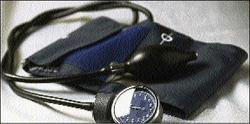Maolynne Miller, Contributor

Believe it or not, hypertension (high blood pressure) does occur in children (from birth to 18 years). It is however, less common in children than in adults. The condition affects an estimated one to two per cent of children.
In children, blood pressure varies with age an so tables should be consulted to determine hypertensive values. Hypertension may have no known cause (essential) or be the result of an underlying medical problem (secondary). The younger the child and the more severe the hypertension, the more likely that the condition is due to an underlying medical problem. Since most cases of secondary hypertension can be cured by correcting the cause, children with hypertension should be vigorously investigated.
Secondary hypertension is more common than essential hypertension, but the frequency of the latter has risen by up to 48.3 per cent in some series, with the higher prevalence of childhood obesity over the last two decades. The child with essential hypertension is usually over 12 years old, obese, female, with mild hypertension and a family history of essential hypertension, obesity and Type II (adult onset) diabetes mellitus.
Over-the-counter drugs
Sixty to 70 per cent of secondary hypertension is due to disease of the kidneys (for example, inflammation, obstruction or birth defects) or abnormalities of kidney blood vessels. Other causes of secondary hypertension include narrowing of the large blood vessel from the heart and excess hormone secretion. Potentially, hypertension-causing drugs include oral contraceptives and over-the-counter products with ephedrine such as preparations for colds and cough.
There is usually no symptom associated with hypertension but children may manifest subtly with poor weight gain and irritability. There may however, be symptoms of the underlying disease, for example, bloody urine and swelling, nervousness, trembling and weight loss. When hypertension is severe, complications include signs of brain or heart involvement - vomiting, headache, blurred vision, seizures, stroke, heart enlargement and heart failure.
Initial investigations involve blood and urine tests and a kidney ultrasound to evaluate for kidney disease. Other tests include electrocardiogram (ECG) and ECHO to examine heart function, structure and size. If the preliminary studies fail to reveal a cause for the hypertension then depending on the age of the child, further tests are performed to exclude other potential causes.
Diet and exercise
All children, especially the obese ones, with confirmed hypertension are counselled on the positive value of healthy eating and exercise on blood pressure. The assistance of a dietician is often needed. While aerobic exercise is recommended, weight lifting (which can raise blood pressure significantly) is not advised when blood pressure is uncontrolled.
In children, antihypertensive drugs usually need to be added for complete blood pressure control. These anti-hypertensives are identical to those used in adults but with weight adjusted doses. Drugs can usually be discontinued in children with secondary hypertension when a cause is found and treated.
The outlook for children with hypertension is good if the condition is diagnosed early, thoroughly investigated and promptly and effectively treated. Regular review appointments are required to monitor response to treatment and compliance with management plans.
Hypertension, however, can only be diagnosed if blood pressure is measured and so routine blood pressure measurement in all children from age three is recommended.
Dr. Maolynne Miller is a consultant paediatric nephrologists and a member of the Paediatric Association of Jamaica; email: yourhealth@gleanerjm.com.
